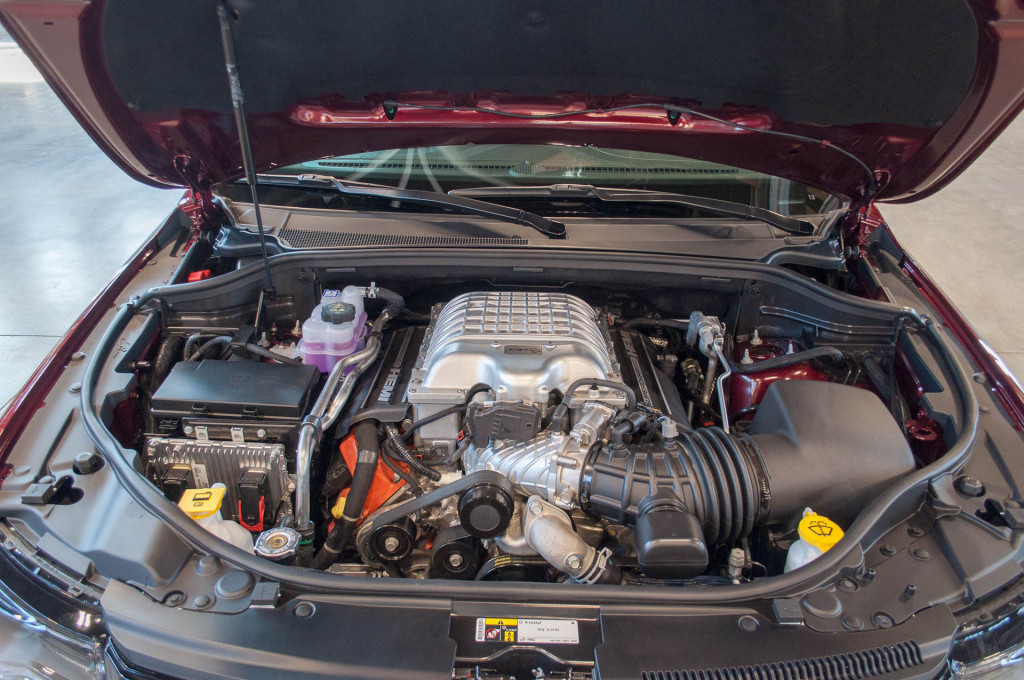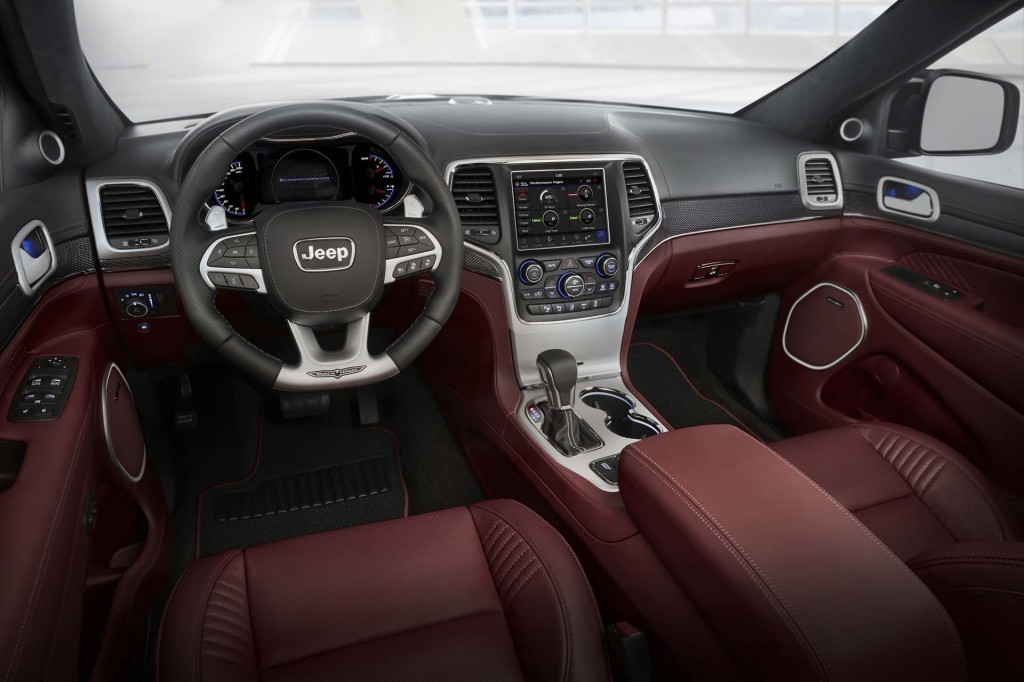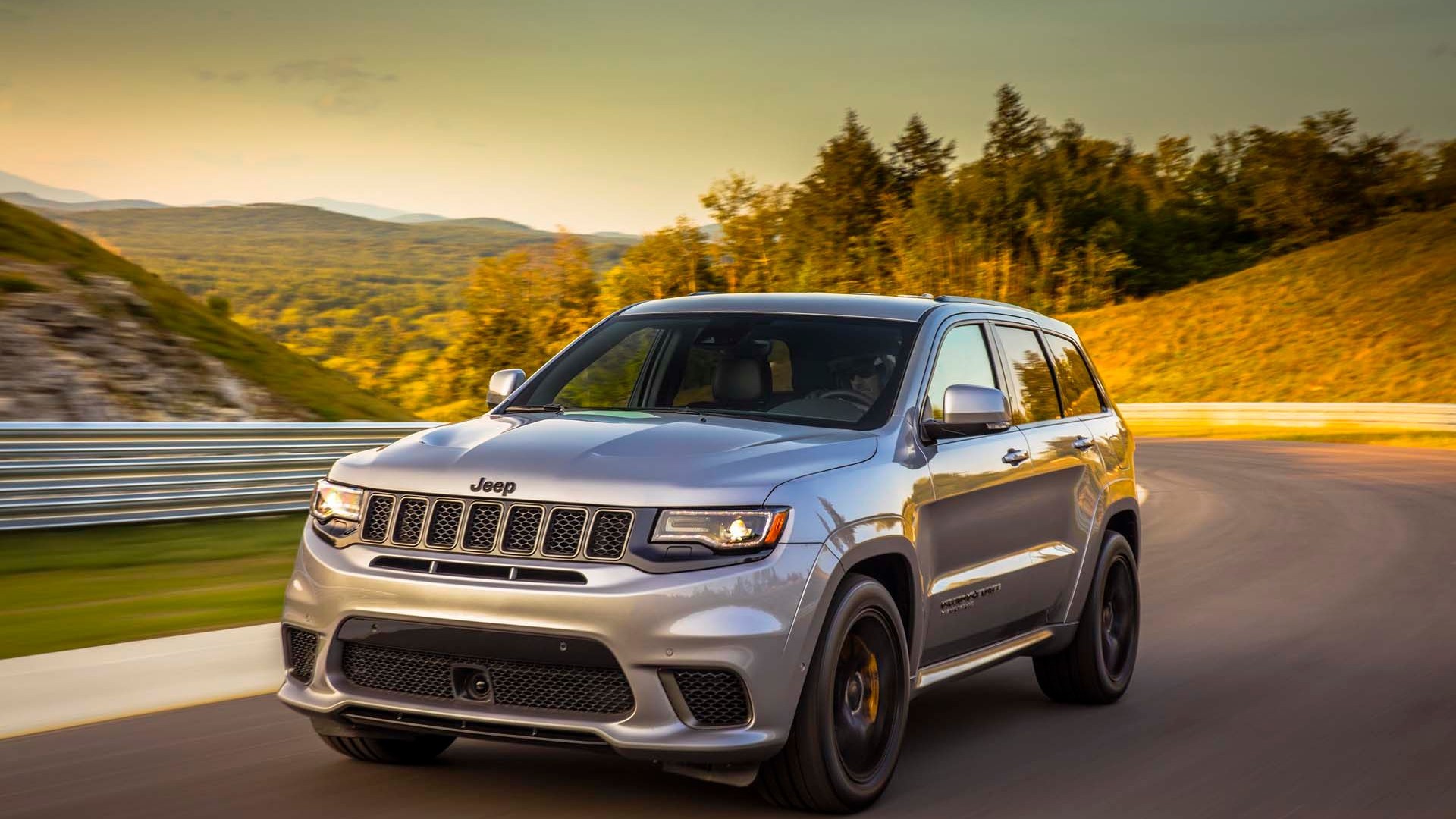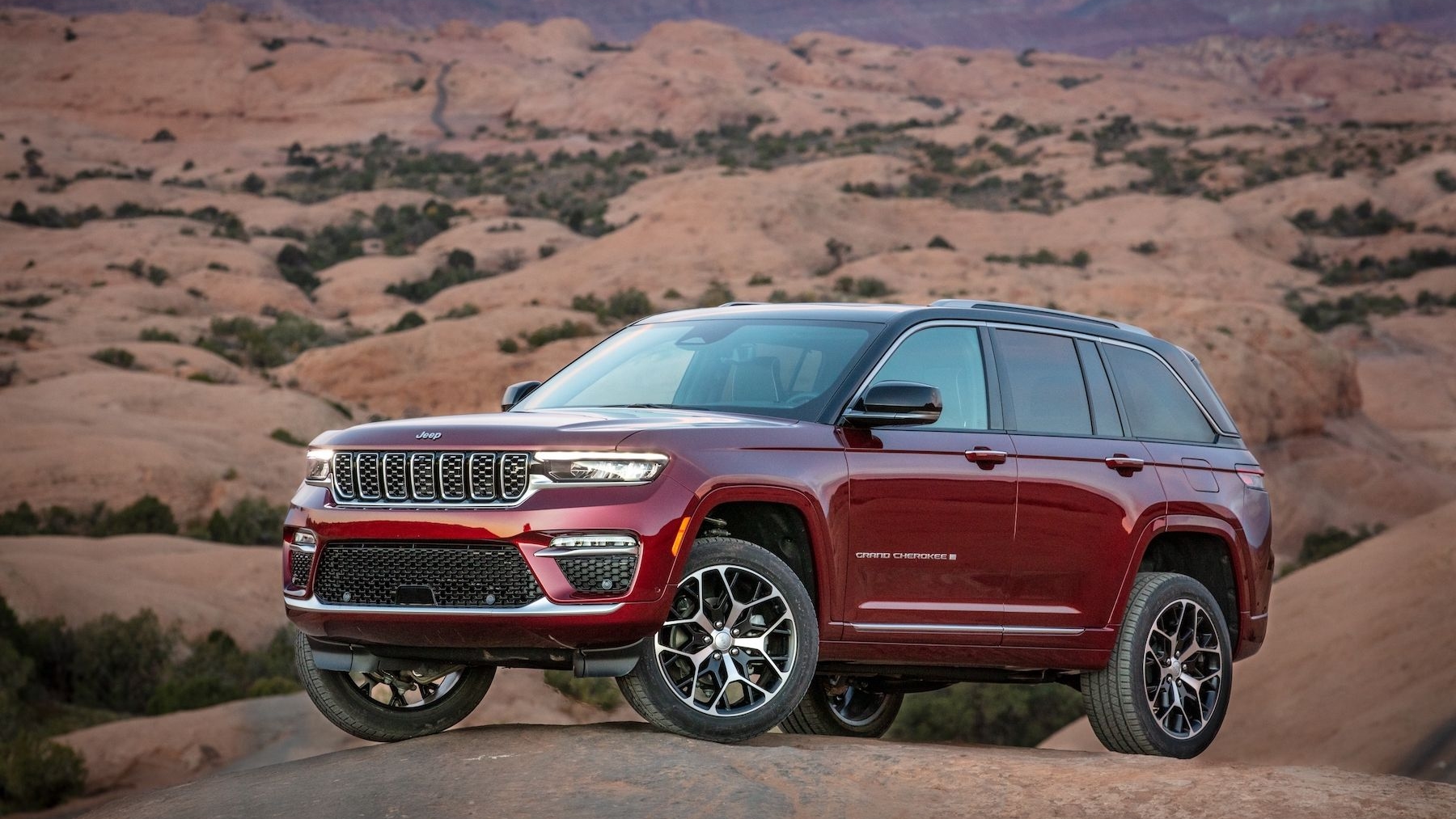Approach the 2018 Grand Cherokee Trackhawk and few external cues give away that this isn’t a normal Grand Cherokee SRT. The front fog lights are missing to allow more air to feed air-to-oil intercoolers, the quad-tipped exhaust features a shiny black chrome finish, Trackhawk specific wheels fill the wheel wells, and two Supercharged badges on the doors along with one Trackhawk badge on the tailgate give away what this really is.
Slide into the driver's seat within the leather-lined interior, push the red start button, and you’ll be met with a familiar, albeit toned down growl from the supercharged 6.2-liter Hemi V-8.
Pull onto the street without mashing the throttle and you might get confused, as there’s no supercharger whine. The blower doesn’t start to make itself known until just over 2,000 rpm, and it’s a lower, more gravelly intake sound than you get in other Hellcats.
The exhaust feels like a wet blanket’s been put over it, until you mash the throttle and it wakes up hell. The Hellcat's exhaust bark upon upshifts and downshifts is present, thankfully, though it's still softer and more refined than the bark of the Charger and Challenger Hellcats, in part due to tuned mufflers from the Durango SRT.
Driving the Trackhawk around the city can be just like driving any other Grand Cherokee, as long as you don't tap too deeply into the 707 horsepower under the hood. You can lope around the streets and you’ll probably average about 13 mpg given our experience, so bring your credit card for frequent fuel stops.
Turn toward a freeway on-ramp, look your co-pilot in the eye to make sure they're ready for what is about to happen, stomp the accelerator to the floor, and feel 1.4 Gs of thrust throw you back into the seat as all four wheels grip at the pavement. Blast onto the highway and realize you had best slow down unless you want to see the inside of a jail cell. Hit the brakes and 15.75-inch two-piece vented Brembo front rotors are grabbed by six-piston calipers to bring things back to reality, quickly.
You may be starting to get the idea that the 2018 Jeep Grand Cherokee Trackhawk is a bit different than other Hellcats while also being the world's most ridiculous SUV. You'd be right.
ALSO SEE: Hellcat Vs. Hellcat: Tires Shredded, Faces Melted, Internet Broken

2018 Jeep Grand Cherokee Trackhawk
An upgraded Hellcat
Engineers didn't just shove the Hellcat powertrain into the Jeep Grand Cherokee to create the Trackhawk. It required much more than that.
Officials from Fiat Chrysler Automobiles told us the Jeep buyer is a different demographic than the Dodge buyer in that they expect more refinement from their Jeeps, and thus, upgrades and modifications were necessary to the engine.
The engine is the same basic supercharged 6.2-liter Hemi V-8 with the full 707 hp of previous Hellcats, and the supercharger still displaces 2.3-liters with 11.6 pounds of boost. It’s what you can’t see underneath the supercharger that’s been enhanced.
Modifications include reduced valve overlap and new cam timing, both to improve idle stability. The exhaust manifold is new with high nickel content and cast iron bits that allow it to handle temperatures as high as 1,740 degrees.
Many of the changes were to quiet the engine and make its sounds more refined. While the Grand Cherokee Trackhawk shares the Dodge Hellcat’s 92 mm throttle body, it has a unique air induction setup with its own air box design, a new air induction tube that modifies the sound of the supercharger whine, and a Helmholz resonator tuned by SRT engineers for this application. No other Hellcat will have a Helmholz resonator, which takes the peaks out of the low and high ends of the sound range, and allows the supercharger whine to build as you step into the throttle instead of being a constant companion.
The mufflers from the Durango SRT were used to achieve the exhaust note and specifically tuned for the Trackhawk.
Jeep had to confront another problem. How would it send 707 hp and 645 pound-feet of torque to all four wheels?
CHECK OUT: Dodge Challenger SRT Hellcat Dyno Tested, May Be More Powerful Than Claimed

2018 Jeep Grand Cherokee Trackhawk
The Trackhawk is the only all-wheel-drive Hellcat, and that required strengthening the Grand Cherokee’s all-wheel-drive system to ensure it wouldn’t explode when dealing with big bursts of power.
The system features a new single-speed active transfer case with a limited-slip rear differential. Engineers had to shorten the transfer case length due to the size of the transmission, which was bolstered to handle up to 860 lb-ft of torque, and use a wider chain with forged steel sprockets that wouldn't break when subjected to a full-throttle launch. The differential has gone from a two-pinion to a four-pinion setup to improve torque capacity, and the casing went from a three- to four-point mount to spread the stress it endures. Even the ring and pinion setup has new tooth geometry to improve tooth bending strength (i.e. so it doesn’t break).
Packaging all this into the Grand Cherokee was no small feat, and the engineers said they were constrained in the rear end by the existing hub design. A new, stronger half-shaft was designed to fit in the current space, and a new 8-ball constant velocity shaft was created as well for increased durability.
Interestingly, the entire front axle and front driveshaft are carryover from the Grand Cherokee SRT, which has "just" 475 hp and 470 lb-ft of torque.
To show off the fruits of its labor, Jeep invited Motor Authority to Portland, Maine, to drive the Trackhawk on the street and track, and try out a few hard 0-60 mph launches for good measure. I drew the mission and was happy to accept it.
Have it your way
If you like Baskin-Robbins, you’ll love how customizable the Trackhawk is. Like other Hellcats, you can go to the performance settings in the 8.4-inch infotainment system and modify the transmission, suspension, and steering settings for Street, Sport, and Track modes.
Then there’s the Selec-Track all-wheel-drive system which has five modes of its own, Auto, Sport, Track, Tow, Snow, and Custom. Each mode modifies the front-to-rear torque split, suspension firmness, and electronic stability control thresholds.
Day to day, you’ll drive around town in Auto mode which splits the torque 40/60 with the ability to vary that based on conditions and slip.
Sport will shift that split to 35/65, and provide quicker shifts and heavier steering, albeit without more feel or quicker responses.
Track is where things are far more fun, thanks to 160-millisecond shifts, the firmest suspension settings, and a 30/70 torque split.
No matter the location, I preferred the Street setting for the steering. Dialing in more artificial heft does nothing outside of making you put more effort into turning the wheel. That's useless.
The differences in the suspension settings are small but noticeable. Street is comfortable enough, though generally the Trackhawk is stiff and you feel every crack in the road even though it’s well-damped. Kicking it all the way to Track mode makes the suspension firmer, but it’s still livable on broken pavement around town.
READ: 2018 Dodge Demon first drive review: Hellcat for real sinners

2018 Jeep Grand Cherokee Trackhawk
The most vicious Hellcat yet
The street portion of the day is done and it's time to learn what the Trackhawk can do when pushed hard. I started by pulling onto the road course at Club Motorsports in Tamworth, New Hampshire.
It takes only one corner at speed on a racetrack to know the Trackhawk is both more refined and controlled than the other Hellcats, and it’s all thanks to that all-wheel-drive system.
Barrel down the front straight, hit 120 mph, brake hard, turn in, and the Trackhawk claws at the pavement, trying to fight the physics of 5,363 pounds of Jeep.
As I ease back into the throttle and climb upward on the track, I quickly realize just how hard and quick the supercharged engine is pulling this ridiculous SUV. For a brief second, before turning to hit the next apex, I smile at how insane reality has now become. Then I hit the brakes hard, turn, and push back into the throttle.
In Track mode, the Trackhawk feels fairly well-balanced as I take a long, right-hand sweeper, despite its weight. Bury the throttle mid turn and the rear end wants to kick out a bit.
To date, the Dodge Hellcat's largest issue has been traction at launch. The Trackhawk doesn’t have that issue in the slightest.
Jeep claims it can do 0-60 mph in just 3.5 seconds using launch control. I proceed to test this claim, multiple times.
I tap the launch control button located near the Selec-Track mode selector, push the brake pedal all the way to the floor as hard as I can, bury the accelerator pedal, take a moment to prepare myself, then release the brake.
Hold on tight.
What I experience is truly violent. My insides shift and it feels as if my brain slides back in my head as the vehicle launches forward with 1.4 Gs of force.
The results? Jeep isn’t kidding. I achieve 3.7 and 3.9-second runs without practice, as indicated by the on-board performance data recorder. Other journalists achieve not only a 3.5-second run, but also even a 3.4-second run. That means it's quicker than advertised.
The best Hellcat yet?
Everything comes with a price, and the Grand Cherokee Trackhawk’s isn’t small.
Starting from $86,995, including destination, the Trackhawk is the most expensive Hellcat you can buy. In fact, it’s more expensive than the 840-hp Challenger SRT Demon. Tick every box on the option sheet and you’ll face a bill of $100,960 including destination. That is a very expensive Jeep Grand Cherokee.
Big ticket items include the the signature leather wrapped interior package which adds $4,995 to the price tag, a rear seat DVD system for $1,995, a panoramic sunroof for $2,095, and upgraded audio for $1,995.
Other options include $995 for 20x10 black satin aluminum wheels, $895 for three-season tires, $495 for a CD player, $995 for a towing package, $395 for a compact spare tire, $95 for red seat belts, and $95 for an engine block heater.
The competition? The Porsche Cayenne Turbo S starts from over $161,000, and the BMW X5 M starts at more than $100,000. Both are less powerful than the Grand Cherokee Trackhawk, but they have roe brand cachet.
The signature leather wrapped interior package almost makes it feel like it can punch with the Porsche and BMW, but the other plastics and switchgear fall down compared to the six-figure rivals.

2018 Jeep Grand Cherokee Trackhawk
In its base form without options, it’s approximately an entire Nissan Versa sedan more expensive than the Charger and Challenger Hellcats. As to whether it’s worth that premium, it’s debatable depending on whether you want a Hellcat that can tow, is more refined, can't do a burnout, and is an SUV.
Without a doubt the Grand Cherokee Trackhawk is the most refined Hellcat you can buy, and the AWD makes it more vicious in a straight line. If you want it raw, you’ll have to buy one of the Dodges, except, they can’t tow 7,200 pounds while heading to the racetrack on a Saturday.
I’m completely and utterly satisfied now. That said: Hey FCA, about that Hellcat-powered Ram Rebel TRX concept?
Jeep provided travel and lodging to Internet Brands Automotive to bring you this firsthand report.









